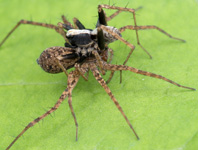Abstract
In this study, a new “non-oxytrichid Dorsomarginalia” ciliate, Urosomoida sejongensis n. sp. discovered from freshwater of the King George Island, Antarctica, was investigated using morphological, morphometrical, and molecular methods. Morphology of U. sejongensis is characterized as follows: body shape slender to elongated; cortical granules spherical and colorless, groups of granules formed patchy distribution; ring-shaped structures scattered in cytoplasm; 27–30 adoral membranelles with undulating membranes in Oxytricha pattern; usually 17 frontal-ventral-transverse (FVT) cirri composed of 3 frontal, 1 buccal, 4 frontoventral, 3 postoral ventral, 2 pretransverse ventral and 4 transverse cirri; 1 right and 1 left marginal rows; 3 dorsal kineties with 1 dorsomarginal row, 3 caudal cirri; 1 micronucleus between 2 macronuclear nodules. This new species mainly differs from other congeners by the combination of following morphological features: a micronucleus, cortical granules, and ciliatures (e.g., adoral membranelles, FVT cirri). Urosomoida sejongensis shows a nucleotide similarity of 97.3% with U. agilis, type of this genus, using the SSU rDNA sequence. Molecular phylogeny shows a non-monophyletic relationship among Urosomoida species and emphasizes the need for further morphogenetic studies of this genus and other related species to resolve morphological convergences.
References
Berger, H. (1999) Monograph of the Oxytrichidae (Ciliophora, Hypotrichia). Monographiae biologicae, 78, i–xii, 1–1080.
http://dx.doi.org/10.1007/978-94-011-4637-1_1Berger, H. (2006) Monograph of the Urostyloidea (Ciliophora, Hypotricha). Monographiae biologicae, 85, i–xv, 1–1303.
http://dx.doi.org/10.1007/1-4020-5273-1_1Berger, H. (2008) Monograph of the Amphisiellidae and Trachelostylidae (Ciliophora, Hypotricha). Monographiae biologicae, 88, i–xvi, 1–737.
Darriba, D., Taboada, G.L., Doallo, R. & Posada, D. (2012) jModelTest 2: more models, new heuristics and parallel computing. Nature Methods, 9, 772.
http://dx.doi.org/10.1038/nmeth.2109Foissner, W. (1982) Ecology and taxonomy of the hypotrichida (Protozoa: Ciliophora) of some Austrian soil. Archiv Für Protistenkunde, 126, 19–143.
http://dx.doi.org/10.1016/S0003-9365(82)80064-XFoissner, W. (1998) An updated compilation of world soil ciliates (Protozoa, Ciliophora), with ecological notes, new records, and descriptions of new species. European Journal of Protistology, 34, 195–235.
http://dx.doi.org/10.1016/S0932-4739(98)80028-XFoissner, W., Agatha, S. & Berger, H. (2002) Soil ciliates (Protozoa, Ciliophora) from Namibia (Southwest Africa), with emphasis on two contrasting environments, the Etosha region and the Namib desert. Part I: Text and line drawings. Denisia, 5, 1–1063.
Foissner, W. & Stoeck, T. (2008) Morphology, ontogenesis and molecular phylogeny of Neokeronopsis (Afrokeronopsis) aurea nov. subgen., nov. spec. (Ciliophora: Hypotricha), a new African flagship ciliate confirms the CEUU hypothesis. Acta Protozoologica, 47, 1–33.
Guindon, S., Dufayard, J.F., Lefort, V., Anisimova, M., Hordijk, W. & Gascuel, O. (2010) New algorithms and methods to estimate maximum-likelihood phylogenies: Assessing the performance of PhyML 3.0. Systematic Biology, 59, 307–321.
http://dx.doi.org/10.1093/sysbio/syq010Hall, T. (1999) BioEdit: a user-friendly biological sequence alignment editor and analysis program for Windows 95/98/NT. Nucleic Acids Symposium Series, 41, 95–98.
Jeanmougin, F., Thompson, J.D., Gouy, M., Higgins, D.G. & Gibson, T.J. (1998) Multiple sequence alignment with Clustal X. Trends in Biochemical Sciences, 23, 403–405.
http://dx.doi.org/10.1016/S0968-0004(98)01285-7Jung, J.-H., Park, K.-M. & Min, G.-S. (2014) Morphology and molecular phylogeny of Pseudouroleptus jejuensis nov. spec., a new soil ciliate (Ciliophora, Spirotrichea) from South Korea. Acta Protozoologica, 53, 195–206.
Medlin, L., Elwood, H.J., Stickel, S. & Sogin, M.L. (1988) The characterization of enzymatically amplified eukaryotic 16S-like rRNA-coding regions. Gene, 71, 491–499.
http://dx.doi.org/10.1016/0378-1119(88)90066-2Paiva, T.S. & Silva-Neto, I.D. (2004) Ciliate protists from Cabiúnas Lagoon (Restinga de Jurubatiba, Macaé, Rio de Janeiro) with emphasis on water quality indicator species and description of Oxytricha marcili sp. n. Brazilian Journal of Biology, 64, 465–478.
http://dx.doi.org/10.1590/S1519-69842004000300010Park, K.-M., Jung, J.-H. & Min, G.-S. (2013) Morphology, morphogenesis, and molecular phylogeny of Anteholosticha multicirrata n. sp. (Ciliophora, Spirotrichea) with a note on morphogenesis of A. pulchra (Kahl, 1932) Berger, 2003. Journal of Eukaryotic Microbiology, 60, 564–577.
http://dx.doi.org/10.1111/jeu.12060Ronquist, F. & Huelsenbeck, J.P. (2003) MrBayes 3: Bayesian phylogenetic inference under mixed models. Bioinformatics, 19, 1572–1574.
http://dx.doi.org/10.1093/bioinformatics/btg180Shao, C., Song, W., Al-Rasheid, K.A.S. & Berger, H. (2011) Redefinition and reassignment of the 18-cirri genera Hemigastrostyla, Oxytricha, Urosomoida, and Actinotricha (Ciliophora, Hypotricha), and description of one new genus and two new species. Acta Protozoologica, 50, 263–287.
Singh, J. & Kamra, K. (2015) Molecular phylogeny of Urosomoida agilis, and new combinations: Hemiurosomoida longa gen. nov., comb. nov., and Heterourosomoida lanceolata gen. nov., comb. nov. (Ciliophora, Hypotricha). European Journal of Protistology, 51, 55–65.
http://dx.doi.org/10.1016/j.ejop.2014.11.005Sonnenberg, R., Nolte, A.W. & Tautz, D. (2007) An evaluation of LSU rDNA D1-D2 sequences for their use in species identification. Frontiers in zoology, 4, 6.
http://dx.doi.org/10.1186/1742-9994-4-6Talavera, G. & Castresana, J. (2007) Improvement of phylogenies after removing divergent and ambiguously aligned blocks from protein sequence alignments. Systematic Biology, 56, 564–577.
http://dx.doi.org/10.1080/10635150701472164Tamura, K., Peterson, D., Peterson, N., Stecher, G., Nei, M. & Kumar, S. (2011) MEGA5: Molecular evolutionary genetics analysis using maximum likelihood, evolutionary distance, and maximum parsimony methods. Molecular Biology and Evolution, 28, 2731–2739.
http://dx.doi.org/10.1093/molbev/msr121Weisse, T., Moser, M., Scheffel, U., Stadler, P., Berendonk, T., Weithoff, G. & Berger H. (2013) Systematics and species-specific response to pH of Oxytricha acidotolerans sp. nov. and Urosomoida sp. (Ciliophora, Hypotricha) from acid mining lakes. European Journal of Protistology, 49, 255–271.
http://dx.doi.org/10.1016/j.ejop.2012.08.001

